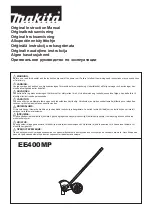
Reddi-Arm Operator’s Manual
Page 13
Mandako Agri Marketing (2010) Ltd.
2.10 MAINTENANCE SAFETY
• Good maintenance is your responsibility. Poor
maintenance is an invitation for trouble.
•
Follow good shop practices.
- Keep service area clean and dry.
- Be sure electrical outlets and tools are
properly grounded.
- Use adequate light for the job at hand.
• Place all controls in neutral, stop engine, set the park
brake, remove ignition key, and wait for all moving
parts to stop before servicing, adjusting, repairing, or
unplugging.
• Place stand or blocks under the frame before
working beneath the machine or when changing
tires.
•
Always use personal protective equipment
such as safety glasses, gloves, and
hearing protection, when performing any
service or maintenance work.
• Where replacement parts are necessary for periodic
maintenance and servicing, genuine factory
replacement parts must be used to restore your
equipment to original specifications.
• A fire extinguisher and first aid kit should
be kept readily accessible while
performing maintenance on this
equipment.
• Relieve pressure on the hydraulic system before
servicing or connecting/disconnecting from tractor.
• Before applying pressure to a hydraulic system, make
sure all components are tight and that steel lines,
hoses and couplings are in good condition.
• When completing a maintenance or
service function, make sure all safety
shields and devices are installed before
placing unit in service.
2.11 HYDRAULIC SAFETY
•
Always place all tractor hydraulic controls in neutral
before dismounting.
• Make sure that all components in the hydraulic
system are kept in good condition and are clean.
•
Replace any worn, cut, abraded, flattened, or
crimped hoses and steel lines.
• Relieve pressure from hydraulic circuit before
servicing or unhooking from tractor.
• Do not attempt any makeshift repairs to the hydraulic
lines, fittings or hoses by using tape, clamps, or
cements. The hydraulic system operates under
extremely high-pressure. Such repairs will fail
suddenly and create a hazardous and unsafe
condition.
• Wear proper hand and eye protection
when searching for a high-pressure
hydraulic leak. Use a piece of wood or
cardboard as a backstop instead of hands
to isolate and identify a leak.
• If injured by a concentrated high-pressure
stream of hydraulic fluid, seek medical
attention immediately. Serious infection or
toxic reaction can develop from hydraulic
fluid piercing the skin surface.
• Before applying pressure to the system, make sure
all components are tight and that lines, hoses, and
couplings are in good condition.














































